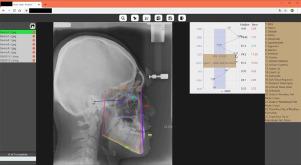Computer Methods and Programs in Biomedicine ( IF 4.9 ) Pub Date : 2020-05-06 , DOI: 10.1016/j.cmpb.2020.105513 Hannah Kim 1 , Eungjune Shim 2 , Jungeun Park 3 , Yoon-Ji Kim 4 , Uilyong Lee 5 , Youngjun Kim 1

|
Background and Objective
An accurate lateral cephalometric analysis is vital in orthodontic diagnosis. Identification of anatomic landmarks on lateral cephalograms is tedious, and errors may occur depending on the doctor's experience. Several attempts have been made to reduce this time-consuming process by automating the process through machine learning; however, they only dealt with a small amount of data from one institute. This study aims to develop a fully automated cephalometric analysis method using deep learning and a corresponding web-based application that can be used without high-specification hardware.
Methods
We built our own dataset comprising 2,075 lateral cephalograms and ground truth positions of 23 landmarks from two institutes and trained a two-stage automated algorithm with a stacked hourglass deep learning model specialized for detecting landmarks in images. Additionally, a web-based application with the proposed algorithm for fully automated cephalometric analysis was developed for better accessibility regardless of the user's computer hardware, which is essential for a deep learning-based method.
Results
The algorithm was evaluated with datasets from various devices and institutes, including a widely used open dataset and achieved 1.37 ± 1.79 mm of point-to-point errors with ground truth positions for 23 cephalometric landmarks. Based on the predicted positions, anatomical types of the subjects were automatically classified and compared with the ground truth, and the automated algorithm achieved a successful classification rate of 88.43%.
Conclusions
We expect that this fully automated cephalometric analysis algorithm and the web-based application can be widely used in various medical environments to save time and effort for manual marking and diagnosis.
中文翻译:

通过深度学习进行基于Web的全自动头颅测量分析。
背景与目的
准确的侧位头颅分析对正畸诊断至关重要。在侧位脑电图上识别解剖标志很繁琐,并且根据医生的经验可能会发生错误。为了通过机器学习使过程自动化来减少这种耗时的过程,已经进行了一些尝试。但是,他们只处理来自一个机构的少量数据。这项研究旨在利用深度学习和相应的基于Web的应用程序开发一种全自动的头颅分析方法,该方法无需使用高规格的硬件即可使用。
方法
我们建立了自己的数据集,其中包括来自两个研究所的23个地标的2,075个侧位头波图和地面真相位置,并且使用专门用于检测图像中地标的堆叠沙漏深度学习模型训练了两阶段自动算法。此外,开发了一种基于Web的应用程序,该应用程序具有用于全自动头颅分析的拟议算法,无论用户的计算机硬件如何,都可实现更好的可访问性,这对于基于深度学习的方法至关重要。
结果
使用来自各种设备和研究所的数据集对该算法进行了评估,包括广泛使用的开放数据集,并获得了1.37±1.79毫米的点对点误差,具有23个头颅地标的地面真相位置。根据预测的位置,自动对受试者的解剖学类型进行分类,并与地面真实情况进行比较,该自动算法的成功分类率为88.43%。
结论
我们希望这种全自动的头颅测量分析算法和基于Web的应用程序可以在各种医疗环境中广泛使用,以节省手动标记和诊断所需的时间和精力。











































 京公网安备 11010802027423号
京公网安备 11010802027423号